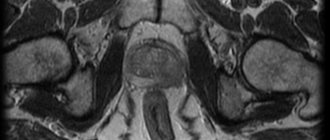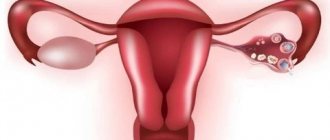How do menstruation progress during menopause?
As you already know from this article, menstruation is typical for the perimenopausal period. At this stage, there is a sharp change in the cyclicity and nature of the discharge. Let's begin our acquaintance with female characteristics from the beginning. Menstruation occurs during the following stages:
- The egg matures and is ready to be fertilized.
- It comes out of the follicle. This process is otherwise called ovulation.
- The endometrium grows inside the uterus.
- If fertilization does not occur, the egg dies.
- The endometrium is rejected and brought out. The usual menstruation comes.
When perimenopause occurs, ovulation occurs less frequently. This is due to the fact that there is not enough estrogen .
Therefore, the process continues only after their level rises. During menopause, the gaps between menstruation are from 40 to 120 days. Once estrogen production stops, menstruation says goodbye forever.
Menopause and menopause are not the same thing!
Menopause is caused by depletion of the supply of eggs in the ovaries and, accordingly, a decrease in the activity of the reproductive system. During menopause, the production of many female sex hormones decreases, which affects the nature of menstruation, the body switches to a new mode of life, “gets used” to a different hormonal balance. The restructuring occurs gradually and stretches over 7-10 years. Therefore, menopause is divided into several periods:
- Perimenopause.
- Menopause.
- Postmenopause.
Menopause is the time when menstruation does not occur for 12 months. However, menopause itself begins 2-4 years before. One of the signs of perimenopause, that is, the first stage of menopause, is a change in the cycle.
https://youtu.be/92RoFZ3Y1zA
How often do menstruation occur during menopause?
Everything here is individual. Gaps can be small - 35–40 days and large - 120 and above. Along with the frequency, the duration of the discharge changes. Contrary to popular belief about the decrease in the number of days, the real facts indicate the opposite. Most women who come to the gynecologist with complaints claim that bleeding lasts 7–12 days. After a few months, it is replaced by short menstruation of 1–2 days and is established in an alternating mode.
There are cases when, during menopause, menstruation occurs for three months in a row. This is pathology. If more than 12 days, contact a specialist. The body, although unbalanced, is not capable, in its right mind and strong memory, of allowing long-term bleeding for no reason.
If your periods have stopped during perimenopause and you suspect that the stage has completely passed, we recommend that you consult a doctor to be sure. It may turn out that the absence of menstruation hides pregnancy , which is still possible. More details here.
Stages of menopause
You can talk about the onset of menopause as soon as its first symptoms appear. However, the decline of reproductive function occurs slowly and is divided into three stages:
- premenopause, when periods are still present, but the cycle becomes longer or less regular, and ovarian function decreases. These processes last about 2 years;
- menopause, when 12 months have passed since the date of the last menstruation;
- postmenopause, which is characterized by increasingly serious changes in the body and complete cessation of ovarian function.
The duration of these stages, as well as the clinical manifestations of menopause, depends on the individual characteristics of the woman, her lifestyle, general health, and heredity.
There is no pregnancy, but my periods are strange - how to explain?
Everything is very simple. Every woman is individual inside and out. No, the organs are the same, and the process is similar, however, its course has variations. Check out the main ones:
- menstruation stops abruptly, then returns after three months. Then they go on for about a year with the indicated frequency, after which they disappear completely;
- menstruation becomes chaotic. Delays of 4–5 months are replaced by short bleeding once every 2–3 weeks. At this rate, perimenopause lasts more than a year;
- The discharge stops suddenly and then never comes. Sometimes there is weakness, hot flashes, however, nothing else reminds of the menopause. In 3% of cases, women have no symptoms at all;
- the cycle changes smoothly. Every month, periods are postponed by 20-30-50 days. The discharge is slight or normal. There are almost no symptoms of menopause. The entire process is completed in two years.
Symptoms of menopause
A decrease in the functioning of the ovaries, which are responsible for a number of functions in the female body, and, in particular, for a decrease in the level of estrogen in the blood, causes various pathologies in the body.
As a result, a woman’s quality of life after menopause, her performance and daily activity decrease. The main signs of the onset of menopause are changes in the menstrual cycle and the so-called “hot flashes”.
Hot flashes during menopause are caused by changes in the level of sex hormones due to decreased ovarian function. Hot flashes appear as a sudden feeling of increased temperature, which is replaced by a feeling of cold. This is accompanied by increased sweating and goosebumps.
It is the restructuring of hormonal levels that determines other disorders that develop during this period of a woman’s life. In terms of intensity and frequency, hot flashes can be mild (up to 10 times a day without other pronounced menopausal symptoms), moderate severity (other symptoms are added to the hot flashes) and severe (more than 20 times a day with a significant deterioration in health and a sharp decrease in ability to work).
Menstruation during menopause becomes less abundant, and the cycle lengthens. After about 2 years, menstruation stops completely.
A woman can guess about the onset of hormonal changes by other early signs of menopause:
- physiological: increased heart rate, headaches, surges in blood pressure, disruption of the genitourinary system and gastrointestinal tract, dry vagina and skin, brittle nails and hair;
- endocrine: decreased libido, weight gain;
- neurological: sudden mood swings, depression, aggression, anxiety, fatigue, muscle weakness, sleep problems, memory problems, speech confusion.
Men's menopause usually proceeds more calmly than women's. Its manifestations, in addition to the symptoms observed in women, include erectile dysfunction, loss of body hair, breast growth, and decreased muscle mass.
Pathologies to watch out for
Alas, one cannot always explain the vagaries of the cycle by menopause. Sometimes they are a signal that the body is being consumed by a serious disease. If you notice pathologies during the primary menopause , contact your gynecologist:
- menstruation has changed in character: the discharge has become thick, the blood is bright brown in color and smells bad;
- Uterine bleeding is normal, but blood clots of a different color are found in it. Pathology indicates a disruption of the endocrine system;
- The bleeding is short but heavy. You change the pad every 30-50 minutes, your stomach hurts a lot, you feel weak and faint.
This is not a complete list, but a basic one. If you don’t find out the cause of the changes in time, you can end up under the surgeon’s knife. And then there is curettage of the uterus, removal of benign or malignant tumors.
Very often, such problems can be avoided by non-hormonal therapy. Phytohormones replace estrogens and maintain women's health at an acceptable level. One of the remedies recommended by doctors is Lignarius. So far, there is simply no analogue to the drug. You can store estrogen for a long time, getting it from food, or take a course of pills to get rid of hot flashes, problems with abnormal discharge and fatigue.
Don't waste your health! Even if you are reassured by another article from the Internet, be vigilant and play it safe. Have a nice day!
Types of menopause
According to the age of onset, menopause can be premature (up to 40 years), early (40-45 years) and late (55-60 years).
Any such deviation from the average age of 45-55 years is considered a pathology and indicates the presence of serious diseases in the body. Pathological menopause is a condition when hormonal changes are accompanied by severe disturbances in the endocrine, cardiovascular, nervous systems and psychological state of a woman.
Artificial menopause occurs after removal of both ovaries (oophorectomy) during radical treatment of severe gynecological diseases, after chemotherapy or radiation therapy and as a result of primary ovarian failure (inability to produce estrogen).=
Additional treatments for CS
What can a woman do on her own to eliminate symptoms?
- Organize your daily routine correctly. It is important to free up more time for rest and sleep at night.
- Create a useful menu. During menopause, the risk of being overweight increases. Proper nutrition will help not only maintain your figure, but also smooth out symptoms and improve the condition of your skin, nails and hair. From the menu you should exclude alcohol, fatty meats and smoked foods, spicy and fried foods, coffee and chocolate, fast carbohydrates (sugar, marmalade, marshmallows, fiber-free fruits, white rice, carbonated drinks). Dairy products, cabbage, legumes, and apples are useful for the prevention of osteoporosis.
- To live an active lifestyle . Regular exercise and exercise have a positive effect on the nervous, respiratory, endocrine and cardiovascular systems, strengthen the musculoskeletal system, and increase immunity. They prevent age-related problems with urination and digestion: they improve intestinal motility and increase the tone of the bladder muscles.
Also, during menopause, antidepressants, vitamins, herbal medicine, and antispasmodics can be used. But the use of these funds should be discussed with a specialist.
For mild cases of CS, physiotherapy is effective: dry carbon dioxide, iodine-bromine baths, electrosleep, galvanization of the “collar” area.
How to take a hormone test correctly?
Blood tests are taken on certain days of the cycle - the day of the test will be calculated by the doctor. So tests for FSH and LH are taken at the beginning of the cycle - on days 4-5. Analysis for estradiol - 19-22 days. Progesterone test at the same time. There are a number of restrictions before donating blood for hormones; they must be observed, otherwise the result will be distorted. Avoid alcohol and physical activity a week before the test. Do not have sex the day before the test day. Take the test strictly on an empty stomach - in the morning, the break from the last meal should be at least 8 hours. You can drink water. Do not take medications.
How to stop bleeding
The beginning of any treatment should occur under the supervision of a physician. Even if you subsequently reduce the amount of menstruation using folk remedies, you need to start with a normal examination and diagnosis. It is more important for you to determine the real cause of the bleeding and begin to treat it, rather than try to cope with heavy menstruation without understanding why it started.
Some of the diseases that cause heavy periods are treated with pills or injections. Others may require surgery to treat.
Cold compresses will help reduce bleeding
If you suddenly experience heavy bleeding from the vagina or uterus, you should call an ambulance as soon as possible, and while it is on the way, do the following:
- lie on your back and place your legs above your head to reduce blood flow to the abdominal area;
- apply cool compresses to the skin in the abdomen (put ice or frozen food in a towel, apply the towel to your abdomen for 10 minutes, then take a five-minute break);
- drink water to prevent dehydration;
- You can drink water with honey and lemon, as they are believed to have hemostatic properties.
Medicines
Several drugs are used to treat major bleeding. They differ in their effects and effects on the body, so they must be prescribed by a doctor.
- Oral contraceptives. Some women doubt whether these drugs can stop bleeding. After all, they do not belong to the group of hemostatic tablets. But since almost all oral contraceptives are hormonal, in some situations they are quite capable of coping with the task.
- Duphaston. Hormonal pills that help stop bleeding. The advantages include the fact that Duphaston does not affect blood clotting in any way.
- Dicynone. A homeostatic drug that increases blood clotting and thereby reduces blood loss.
- Vikasol. It is an artificially created vitamin K, it affects blood clotting, due to which it stops blood loss.
- Transekam. It comes in the form of tablets or injections. Belongs to the group of hemostatics, it helps stop bleeding well.
- Aminocaproic acid. Increases blood clotting by dissolving blood clots and clots.
The attending physician will select a drug for the treatment of heavy menstruation
Most of the prescribed drugs affect blood clotting, so you should not start using them without a doctor’s prescription. After all, if you have any diseases associated with the circulatory system, then you can worsen your condition. And most women over the age of 50 have venous dilation.
Why do you need to know these values?
To prepare for menopause. In addition to prescribing replacement therapy, a woman should introduce calcium-containing foods into her diet: cottage cheese, fermented milk products, cheese to prevent osteoporosis. You need to undergo a gynecological examination: take a smear for oncocytology, do an ultrasound of the pelvic organs and mammography. You should donate blood for sugar and cholesterol levels. Adjust your diet, move more, follow a sleep and rest schedule. Your doctor may prescribe vitamins or supplements to relieve menopausal symptoms.
Obstetrician-gynecologist of the highest category. Chernovskaya Rosa Uranovna
How to diagnose pathology?
Menopausal bleeding requires careful diagnosis using the most modern methods. Only they can accurately establish the diagnosis, the cause, and only then can treatment be prescribed. First of all, you will need a detailed medical history, in which the doctor will find out the symptoms, history of the onset of menstruation, childbirth, abortion, surgery and other manipulations. The doctor may also ask about breastfeeding and the presence of gynecological diseases in close relatives. A thorough gynecological examination is required, during which smears are taken from the vagina. Based on initial examinations, the following diagnostic procedures can be prescribed:
- Testing for a hormonal panel, blood testing and blood clotting.
- Additional studies of the liver, kidneys, and thyroid gland.
- Testing for tumor markers, liver tests.
- A vaginal or transvaginal ultrasound is performed.
- A biopsy is performed and biological material is examined to detect cancer.
- An MRI of the pelvic organs is performed
Depending on the results of the study, additional examination procedures may be prescribed. Sometimes the diagnosis of uterine bleeding requires consultation not only with a gynecologist, but also with an endocrinologist, mammologist, oncologist, therapist, and hematologist. If a woman has a number of concomitant diseases, then this problem must be solved comprehensively, using all available specialists.
What symptoms are typical for bleeding?
Treatment of bleeding during menopause is a process that requires a careful study of the symptoms of the disease. The main sign of pathology is the presence of bloody discharge. They can be very abundant, and sometimes quite scanty; often such bleeding resembles a “daub”, in which the discharge of blood is insignificant. Sometimes they contain mucus. The color can also be different: from bright scarlet to dark brown. But regardless of this, even a small amount of blood should be considered bleeding. It also happens that the blood changes color from red to black. All these symptoms are extremely dangerous and can indicate the presence of infections, tumors and various problems.
Particularly dangerous symptoms of bleeding are considered to be fever, dizziness, pale skin, cold sweat, a prolonged period of discharge, sharp pain in the lower abdomen, a feeling of heaviness and “fullness” of the space in the lower abdomen. The worst and most dangerous symptom is sudden, heavy bleeding, in which the blood is bright scarlet, not thick, but rather liquid. In this case, the bleeding does not stop and increases, and there is a sharp, throbbing pain in the abdomen. Such conditions require emergency hospitalization and can even lead to the death of the patient.
Why does spotting occur during menopause?
There can be many reasons for bleeding during menopause. Some of them are quite harmless, but there are others that indicate a serious illness. As a rule, a woman cannot figure this out on her own, as this requires a detailed consultation with a doctor. But treatment of uterine bleeding during menopause is required almost constantly, and how it will proceed depends on the reasons.
The causes of bleeding during menopause can be:
- Hormonal disorders.
- Taking certain medications, including hormonal and contraceptive medications.
- Early onset of menstruation, absence of labor or a large difference between them, refusal to breastfeed.
- Heredity.
- Uterine fibroids.
- Uterine cancer.
- Ovarian dysfunction.
- Endometriosis.
- Endometrial hyperplasia.
- Polyps that are on the endometrium.
- Vaginitis
- Tumors, ovarian cysts.
- Ovarian cancer.
- Cervical cancer.
When are your periods heavy?
More often, the premenopausal period is characterized by a decrease in discharge during menstruation. However, under certain conditions and diseases, they can become, on the contrary, abundant. There are the following reasons for this:
- malignant neoplasms on the uterus, for example, with abundant erosion;
- benign tumors of the uterus - polyps, fibroids;
- frequent sexual intercourse;
- active physical activity that is not commensurate with the patient’s health.
Women do not always understand what increased discharge means. This means that the amount of blood increases by 60-90 ml every day. The duration of the cycle can reach up to 7 days or more. Profuse blood loss occurs. Therefore, the patient does not have enough red blood cells and hemoglobin. Iron deficiency anemia develops. This condition causes a sharp loss of strength, headache, dizziness, pale skin, and pain.
After treatment, periods may occur again. If a woman’s age is characterized by a gradual onset of menopause, they will become less and less common. Anemia will gradually disappear, and the patient’s well-being will improve significantly. This is a normal, physiological phenomenon.









